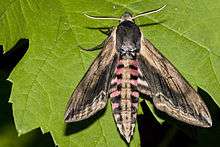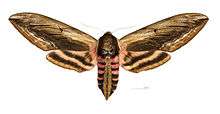Sphinx ligustri
| Privet hawk moth | |
|---|---|
 | |
| Scientific classification | |
| Kingdom: | Animalia |
| Phylum: | Euarthropoda |
| Class: | Insecta |
| Order: | Lepidoptera |
| Family: | Sphingidae |
| Genus: | Sphinx |
| Species: | S. ligustri |
| Binomial name | |
| Sphinx ligustri | |
| Synonyms | |
| |
Sphinx ligustri, known as the privet hawk moth, is a species of moth found in most of the Palearctic ecozone.
Description
It has a 12 centimetres (4.7 in) wingspan (generally deflexed at rest), and is found in urban areas, forests and woodlands.
The male privet hawk-moth can make a hissing sound, if disturbed, by rubbing together a set of scales and spines at the end of its abdomen.
The larvae are usually found between July and August: and bury themselves in the earth when preparing to become a pupa. They then fly in the following June.[2]
Diet
As its name describes, the caterpillars feed on privets, as well as ash trees, lilacs, jasmine, and a number of other plants.
Gallery
 Male, dorsal side - MHNT
Male, dorsal side - MHNT Male, ventral side - MHNT
Male, ventral side - MHNT Female, dorsal side - MHNT
Female, dorsal side - MHNT Female, ventral side - MHNT
Female, ventral side - MHNT
 Caterpillar
Caterpillar Pupating
Pupating Pupa
Pupa Pupa, caterpillar, and adult
Pupa, caterpillar, and adult
References
- ↑ "CATE Creating a Taxonomic eScience - Sphingidae". Cate-sphingidae.org. Archived from the original on 2012-11-26. Retrieved 2011-11-01.
- ↑ Donovan, Edward (1792). The natural history of British insects: explaining them in their several states, with the periods of their transformations, their food, economy, &c. together with the history of such minute insects as require investigation by the microscope: the whole illustrated by coloured figures, designed and executed from living specimens. London. p. 79.
External links


- Privet hawk moth on UKMoths
- Pittaway, Tony, Sphingidae of the Western Palaearctic, retrieved 2017-03-18
- The entry for this species on Australian Museum
- Lepiforum.de
This article is issued from
Wikipedia.
The text is licensed under Creative Commons - Attribution - Sharealike.
Additional terms may apply for the media files.